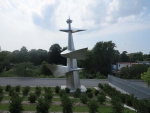Henri-Georges Adam
Obélisque oblique
1967
Presentation of the artwork
The artwork was moved a small distance from its original site when the former French pavilion was converted to a casino. Its quadrangular shape, topped with a point, is the contemporary expression of an obelisk. Rather than the inscriptions that are usually found on obelisks, four blank, streamlined forms have been slipped on to the cone. The entire sculpture is made of stainless steel. The four pointed forms point in different directions, like road signs at a crossroads, and indicate the idea of human fate pointing in all directions. The artwork addresses the concerns and events that influenced the artists of Adam’s generation: on the one hand, industrialization and the machine, and, on the other hand, the two world wars. It conveys the search for a new language that corresponds to the context of modernity. Associated events
The artwork was presented outside the French pavilion at the 1967 World Fair.
Henri-Georges Adam
Henri-Georges Adam was born in Paris on 14 January 1904. Early in his career, he was a printmaker and associated with the surrealists. He began to work in sculpture in 1942, and the following year he produced his first major sculpture, Le Gisant. In 1947, he began to experiment with tapestry. He had a number of important exhibitions: at the Berne Kunsthalle in 1948, the Venice Biennale in 1950, the Milan Triennale in 1951, the Sao Paulo Biennale in 1953, Amsterdam’s Stedelijk Museum in 1955, and Documenta in Kassel in 1959. He received significant commissions for large tapestries for the French embassy in Washington in 1957, the Palais de l’UNESCO in 1958, and the Air France branch in New York in 1961. He had a major exhibition at the Musée national d'art moderne de Paris in 1966. Three of his artworks were presented at the 1967 World Fair. He died on 27 August 1967 in Clarté, Brittany.
Awards and honours
- Prix Blumenthal (gravure), 1938
- Prix de la gravure à la Biennale de sao Paulo, 1953
- Grand Prix International de gravure de Ljubljana, 1957
- Chevalier de la Légion d'honneur, 1958
- Chevalier de l'Ordre National du mérite, 1964
- Commandeur de l'Ordre des arts et des lettres, 1965






